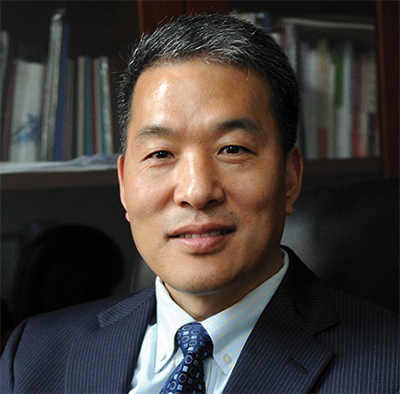Meet Qi-Qun Tang
Brown fat generates heat and white fat increases our risk of metabolic disease, but what of the beige that lies between? At Fudan University Shanghai Medical College, Qi-Qun Tang and his colleagues are investigating the metabolic processes by which stem cells become white, brown or beige fat; the third of these exhibits some of the heat-generating, circulation-inducing characteristics of its brown counterpart.
 Since Qi-Qun Tang started as an associate editor at the Journal of Biological Chemistry, more than a third of the papers he’s edited have come from primary and senior authors based at institutions in China.Courtesy of Qi-Qun Tang
Since Qi-Qun Tang started as an associate editor at the Journal of Biological Chemistry, more than a third of the papers he’s edited have come from primary and senior authors based at institutions in China.Courtesy of Qi-Qun Tang
After receiving a medical degree in 1990 and a Ph.D. in 1995 from Fudan University Shanghai Medical College, Tang did his postdoctoral research at Johns Hopkins University in the lab of M. Daniel Lane, a pioneer in understanding adipocyte differentiation. Tang became an assistant professor at Hopkins in 2002. He returned to Fudan University in 2005, and he now divides his time between his lab in Shanghai and his family in Baltimore. He became the Journal of Biological Chemistry’s first associate editor in China in late 2017 and now evaluates research papers on adipocyte development and function, carbohydrate metabolism, and cellular signaling related to liver metabolism.
As vice president of the Chinese Society for Biochemistry and Molecular Biology, Tang helped coordinate the society’s annual meeting this month in Taiuyan; its close to 2,500 attendees will include a dozen JBC editorial board members. He also helped organize a joint symposium by the CSBMB and the ASBMB, “Epigenetic Control of the Epigenome,” this month in Suzhou, near Shanghai.
Tang spoke with John Arnst, an ASBMB Today science writer, about his work. The interview has been edited for clarity and length.
What is your research group at Fudan University working on?
We originally worked on adipogenesis, which is how stem cells can become fat cells. These days, we mainly focus on adipose tissue as a whole, because it doesn’t just consist of adipocytes; it’s also stem cells, immune cells and preadipocytes. We’re also looking at angiogenesis of blood vessels. We’re really interested in plasticity and how adipose tissue is remodeled.
We always think of adipose tissue as fairly important for storing energy that can be released when required. Normally, the adipose tissue itself is really healthy. But later, when it becomes chronically inflamed, this tissue becomes unhealthy, or there is a risk for metabolic diseases. So we’re currently focused on subcutaneous, or white, fat because it accounts for most of the fat in bodies it can actually be induced to be beige, or brownlike, adipose tissue.
That beige fat has characteristics somewhere between white and brown fat, right?
Correct. During exposure to cold temperatures or exercise, those white adipocytes can actually be induced to become beige cells. And then later, after that stimulation is removed, they tend to turn back. That modeling and remodeling also stimulates angiogenesis, the generation of blood vessels, and induces change to the immune system’s macrophages.
It’s a whole host of changes, and we’re trying to really unravel those physiological processes. It’s an exciting area, because these beige cells were only identified around 10 years ago, but the field is now moving very fast.
One of the cytokines we’ve been working on is BMP4, which can induce the adipocytes to transform to beige cells. It also upregulates the production of M2 macrophages and activates them, and it induces angiogenesis. It’s one of many factors we’re looking at, and we’re also trying to use some of the latest omics to identify new factors.
It seems like a burgeoning field.
The field is very hot right now. We’re also using screens to test the ability of chemical compounds to induce white adipocytes to become beige. One is called artemisinin, which was originally used to treat malaria. It’s a famous compound extracted from sweet wormwood (author’s note: Chinese chemist Youyou Tu won a 2015 Nobel Prize in medicine for isolating and chemically identifying the compound, which had long been used in folk medicine). That’s just one of the compounds that we are working on.
How did you find yourself involved in adipogenesis?
I was training for my M.D. in forensic medicine, but I didn’t like it very much.
During my second year of medical training, in 1988, one of my supervisors saw this and let me know that molecular biology was booming and that it could be a really exciting career. So, once I wrapped up my M.D., I got started on my Ph.D.
I started with the adipocyte research after I got to Hopkins for my postdoctoral training. At the time, we were trying to understand how a preadipocyte turns into an adipocyte. I mainly focused on C/EBP beta (author’s note: CCAAT/enhancer-binding protein beta), which is an upstream transcription factor for the C/EBP alpha and PPAR gamma. They are really a master transportation regulator for adipocyte genes, and they are transcription factors that can turn on almost all the genes involved in the adipocyte differentiation. A few years back, I wrote a JBC review about how C/EBP beta regulates all of these genes.
And you’ve been involved with subsequent JBC reviews. What has your work looked like with JBC in recent years?
I published my first of several papers in JBC in 2009 and was invited to become an editorial board member a few years later.
Right now, I’m really interested in helping to promote the journal in China.
The journal has always been helpful to young scientists who are trying to understand how to improve the quality of their papers. In China, the stakes for submission are very high, but JBC’s acceptance rate is low. I think at least part of the reason is the quality. So I think that we can work with the journal to have a lot of impact on the societies within the CSBMB society.
I’m glad you mentioned the Chinese Society for Biochemistry and Molecular Biology. I was wondering how you divide your time between China and the United States.
I spend most of my time in China right now. We have a summer break and a winter break, and I sometimes come back here for meetings during the middle, like ASBMB’s annual meeting. I probably spend eight or nine months of the year in China.
That’s an impressive balancing act. Do you have advice for early-career scientists about balancing life in the lab and life outside of the lab?
Keeping some outside activity is really important. These days, I go to the gym a lot, and I’ve hired a personal trainer. I was diagnosed as being prediabetic in 2004, and because I work in understanding metabolism, I wanted to be on top of dealing with it.
I think another good outlet for when you get really stressed out, especially early on, is going swimming for a while. Then, you can totally forget about stress, you can refresh your mind to start working again. I used to go in the afternoon, and after I’d come back, I’d feel refreshed.
There is definitely something unique to swimming in that regard. The only thing you have to focus on is the bottom of the pool, and maybe the upcoming wall.
You can just let your brain completely relax and go wherever it needs to. And then when you come back, your mind is crystal clear to do your work.
Enjoy reading ASBMB Today?
Become a member to receive the print edition monthly and the digital edition weekly.
Learn moreGet the latest from ASBMB Today
Enter your email address, and we’ll send you a weekly email with recent articles, interviews and more.
Latest in People
People highlights or most popular articles

2024 voter guide
Learn about the candidates running for ASBMB Council, Nominating Committee, Publications Committee and treasurer.

Charles O. Rock (1949 – 2023)
Colleagues and trainees remember a world expert in membrane lipid homeostasis.

Honors for Clemons, Hatzios and Wiemer
Awards, honors, milestones and more. Find out what's happening in the lives of ASBMB members.

Touching the future from the bench
Scholar, scientist, teacher and mentor Odutayo Odunuga discusses the important roles of the institutional PI, his journey and his research.

In memoriam: Darwin Prockop
He held leadership positions at multiple institutions and was known for his contributions to adult stem cell biology and cellular biology.

A look into medical writing
Our careers columnist spoke with Ashlea A. Morgan at Chameleon Communications International to get a sense of one type of work a medical writer can do.

